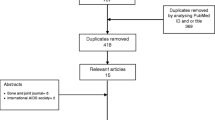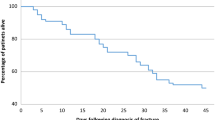Abstract
Background
There are an estimated 6,900 people with HIV living in Ireland. There is a significant prevalence of femoral osteonecrosis and risk factors for osteoporotic fractures. With this potential, increasing surgical workload, it is important to assess surgical demand and audit outcomes.
Methods
The hospital’s electronic records were examined. Between January 2005 and August 2011, 17 femoral surgeries were identified in seven patients. Patient records were retrospectively reviewed.
Results
Elective operations undertaken were eight hip replacements and one nail dynamisation. Eight emergency operations were undertaken: two DHS, one plating, one nailing, one revision nailing, two incision and drainages and one biopsy. All procedures were carried out using appropriate safety guidelines. Indications for surgery included femoral head osteonecrosis (n = 7), osteomyelitis (n = 3), proximal femoral fracture (n = 2), femoral shaft non-union (n = 1), dynamisation of a nail (n = 1), osteoarthritis (n = 1), fractured femur (n = 1), and revision nailing (n = 1). For two procedures the patient was not on highly active anti-retroviral treatment. All elective patients had CD4 counts greater than 200 pre-operatively. Six patients had undetectable viral loads. Of the eight emergency procedures, four procedures had no preoperative immune status recorded. Complications recorded were three non-unions, one nail fracture, one lesser trochanter fracture and recurrence of osteomyelitis. No surgical site infections were recorded.
Conclusions
Complications were not related to immune status. The rate of surgical site infection in both elective and emergency procedures was low. The elective surgery patients can safely receive orthopaedic treatment in their regional orthopaedic unit. Due to the high non-infectious complication rates recorded in the emergency group, transfer to a tertiary facility with infectious disease expertise is advised.
Similar content being viewed by others
References
Health protection surveillance centre (2011). http://www.hpsc.ie/hpsc/A-Z/HIVSTIs/HIVandAIDS/SurveillanceReports/File,13068,en.pdf
AVERTing HIV and AIDs. www.avert.org
Kiboneka A, Nyatia RJ, Nabiryo C et al (2009) Combination antiretroviral therapy in population affected by conflict: outcomes from large cohort in northern Uganda. BMJ 17(338):b201
Palella FJ Jr, Delaney KM, Moorman AC et al (1998) Declining morbidity and mortality among patients with advanced human immunodeficiency virus infection. HIV outpatient study investigator. NEJM 338:853–860
Williams I, Churchill D, Anderson J et al (2012) British HIV Association guidelines for the treatment of HIV-1-positive adults with antiretroviral therapy 2012. HIV Med 13(Suppl 2):1–85
Carr A, Samaras K, Burton S et al (1998) A syndrome of peripheral lipodystrophy, hyperlipidemia, and insulin resistance in patients receiving HIV protease inhibitors. AIDS 12:F51–F52
Tebas P, Powderly WG, Claxton S et al (2000) Accelerated bone mineral loss in HIV-infected patients treated with potent antiretroviral therapy. AIDS 14:F63–F67
Moore AL, Vashisht A, Sabin CA et al (2001) Reduced bone density in HIV positive individuals. AIDS 15:1731–1733
Madeddu G, Spanu A, Solinas P et al (2004) Bone mass loss and vitamin D metabolism impairment in HIV patients receiving highly active antiretroviral therapy. Q J Nucl Med Mol Imaging 48:39–48
Appay V, Sauce D (2008) Immune activation and inflammation in HIV-1 infection: causes and consequences. J Pathol 214:231–241
Kearney F, Moore AR, Donegan CF et al (2010) The ageing of HIV: implications for geriatric medicine. Age Ageing 39(5):536–541 Epub 2010 Aug 4
Tebas P, Powderly WG, Claxton S et al (2000) Accelerated bone mineral loss in HIV-infected patients receiving potent antiretroviral therapy. AIDS 14(4):F63–F67
Medical management of older patients with HIV/AIDS (R01) (2010). [on-line]. Available at http://grants.nih.gov/grants/guide/pa-files/PA-09-017.html. Accessed 14 Jan 2010
Smith RD, Delpech VC, Brown AE et al (2010) HIV transmission and high rates of late diagnoses among adults aged 50 years and over. AIDS 24(13):2109–2115
Sharma A, Flom PL, Weedon J et al (2010) Prospective study of bone mineral density changes in aging men with or at risk for HIV infection. AIDS 24(15):2337–2345
Estrella MM, Kirk GD, Mehta SH et al (2012) Vitamin D deficiency and persistent proteinuria among HIV-infected and uninfected injection drug users. AIDS 26(3):295–302
Yombi JC, Vandercam B, Wilmes D et al (2009) Osteonecrosis of the femoral head in patients with type 1 human immunodeficiency virus infection: clinical analysis and review. Clin Rheumatol 28(7):815–823
Drapeau CM, Pan A, Bellacossa C et al (2009) Surgical site infections in HIV-infected patients: results from an Italian prospective multicenter observational study. Infection 37(5):455–460
Abalo A, Patassi A, James YE et al (2010) Risk factors for surgical wound infection in HIV-positive patients undergoing surgery for orthopaedic trauma. J Orthop Surg (Hong Kong) 18(2):224–227
Wiley MM (2005) Using HIPE data as a research and planning tool: limitations and opportunities: a response. IJMS 174:2
Wieser K, Zinqq P, Betz M et al (2012) Total hip replacement in patients with history of illicit injecting drug use. Arch Orthop Trauma Surg 132(7):1037–1044
Author information
Authors and Affiliations
Corresponding author
Rights and permissions
About this article
Cite this article
Cummins, F., Ramasubbu, B., McCarthy, T. et al. Surgery of the femur in HIV positive patients: a retrospective review from 2005 to 2011. Ir J Med Sci 184, 505–510 (2015). https://doi.org/10.1007/s11845-014-1156-6
Received:
Accepted:
Published:
Issue Date:
DOI: https://doi.org/10.1007/s11845-014-1156-6




